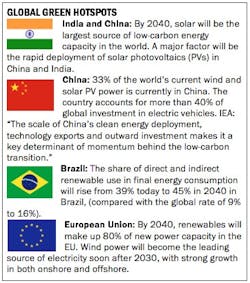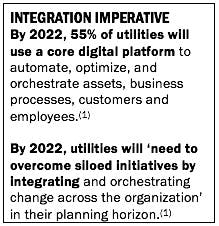2019: DIVERSIFY OR DISAPPEAR FOR ENERGY, UTILITIES AND RESOURCES?
INDUSTRY PREDICTIONS 2019
Author: Colin Beaney, IFS Global Industry Director for Energy, Utilities & Resources
Renewables accelerating even faster than previously predicted, CX and UX driving innovation, a new generation of proactive consumers driving demand for more diversified energy, business and payment models: In 2019 energy and utility companies face the challenges of an industry rapidly diversifying, decentralizing and digitizing. The sure-fire way to keep up? Make sure you stay ahead….
Prediction #1:
By 2040, 66% of the global energy market will be in renewables, driving an urgent race to diversify in 2019
By 2040 the equivalent of a whole new China and India will have been added to the planet’s global energy demand, a 30% increase on today. The IEA (International Energy Agency) reports that by 2040 renewables will meet 40% of the planet’s energy demands. This will also be driven, the report says, by ‘enormous efficiency improvements on the supply side’.
Diversification, beginning now, is key to seizing the opportunity. And as the table shows (right), this is not just a European trend. Worldwide, the direct use of renewables to provide heat and mobility will double by 2040.
So in 2019, traditional major energy providers and even heavy industries will all be racing to adapt to the rise of renewables.
The last mile hots up
And as they compete to capture the green euros of more proactive, eco-conscious consumers, energy and utilities companies will focus more and more on smart grid management and customer service.
Take National Grid Smart, in the UK. Its solutions support the UK-based National Grid’s new smart meter initiative. The initiative expects to fit 26 million domestic smart meters in the country by 2020, powering national energy efficiency. Using IFS Applications, the company offers national energy suppliers a fully-managed smart meter service, with asset financing and installation, managed logistics and customer communications, also feeding critical data from engineers in the field via IFS Mobile Work Order application. These advanced capabilities in the last mile deliver a powerful competitive edge for energy providers.
Prediction 2:
By 2023, 75% of utilities assets will be digitally connected(1)—but how they’re integrated will be make or break
For proactive consumers, diversification means more options over which energy they use, how much they pay for it and even how they can store and sell it back. For energy and utility companies, it also means more complexity. And the urgent need for accessible data throughout. A recent IDC Report (1) says that over the next five years the need to power predictive maintenance and extend asset life cycle will drive 75% of critical utilities assets to be digitally connected. But it’s how well integrated AI and IoT technologies are that will ultimately turn all this data into value.
Integrated smart drilling
One of our customers in the offshore drilling sector operates one of the youngest but most advanced fleets of oil rigs in the industry—including the largest harsh-environment jack-up rigs in the world, deepwater drillships and semi-submersible rigs. All are run as individual business units earning revenue in locations as far apart as the Gulf of Mexico, Africa and South East Asia. In a typical situation like this, an integrated system undoubtedly helps increase efficiency, quality and reduce operational costs. Before the company rolled out IFS Applications globally, its software landscape included six separate software systems.
In 2018, we saw a growing number of energy and utilities companies look to upgrade their applications. Two major utilities in Norway, Sogn og Fjordane Energi and Glitre Energi, both chose to upgrade to IFS Applications 10, and this need for advanced capabilities and integration will continue to be a powerful factor moving forward.
The mining industry is a great example. In 2018, most mining companies invested heavily in IoT sensors and technology. 2019 will be the year these investments must begin to deliver (2. And again, integration will be critical:
Integration imperative: Industry spotlight—mining
· Companies that fail to integrate at least 50% of their operations and IT systems by 2022, will gain no value from digitalization regardless of strategy, organization, or technology focus (1)
· 50% of mining companies that prioritize an integrated approach to tracking yield will achieve an industry-leading performance by 2022 (1)
· Companies that embrace continuous improvement and digital innovation as a single integrated business process will outperform peers in terms of profitability by up to 20% by 2021 (1)
Prediction 3:
By 2024, 25% of extraction and mining companies will have created digital twins (2)
Digital twin key driver #1: Integration. The IDC FutureScape Mining report (2) predicts that by 2024, 25% of mining companies will have created digital twins—specifically in order ‘to integrate geospatial, geological and mine operation insights’, to better integrate planning, execution, and maintenance. Overcoming the challenge of siloed data will be a key driver of digital twins.
Digital twin key driver #2: automation. As reserves shrink, companies are exploring ever tougher, more remote terrain. And in harsh environments like these, automated equipment delivers multiple benefits: Onsite robots are more cost-effective, resilient and able to operate for longer hours, more accurately even in severe conditions. With integration in place, automated assets are perfect for digital twin simulations too. Leveraging digital twins for automated assets massively cuts risk in both operational and investment decisions. From planning to development to production and maintenance—every dollar can be accounted for and measured before any risk is taken. The savings and competitive edge this produces means that while traditionally high-risk, high-automation industries like mining and aviation pioneer digital twins, uptake will soon follow in all industries where complex asset management is crucial.
Prediction 4:
Energy & utility retailers will double their AI investments in 2019 as they battle to boost customer experience
As we’ve alreadyseen, the customer is priority #1 in the energy and utility sector right now. In 2019, even more so. The competition to enhance customer experience (CX) by improving convenience, customization, and control is intensifying. In 2019, it will drive many retailers in the sector to double their investments in AI. (1)
As energy and utility providers compete on customer service, they’ll look to provide a more retail-like customer experience model. One where customers can get the right personalized energy solution, on the channel they want, in just a few clicks. Take HomeServe in the UK. They install gas residentially and carry out approximately 300,000 calls and 200,000 visits a year. When they installed IFS’s AI-powered omni-channel contact center solution it included all customer, asset, field service scheduling and parts information, meaning HomeServe Gas agents no longer had to search in multiple screens or systems for different data, all contextual data they needed to resolve customer requests is delivered to the agent as and when they need through their service desktop. This transformed the experience that agents were able to offer customers.
AI wins the customer war on two fronts
So AI delivers a double benefit: it enables better customer experience—as well as significant savings and efficiencies on the operational side. And cutting supply costs will be essential to cutting prices and winning customer loyalty in an increasingly crowded marketplace. But, just as before, integration will be critical to winning that war.
Energy and utility companies need omni-channel customer service centers just like HomeServe’s, offering voice and digital self-service. And they need to integrate all supply and enterprise data into one system. Being able to join up the dots instantly, from the field to the last mile of the consumers’ home, is non-negotiable if you’re going to win customer engagement. Again, AI will be a powerful driver—with the right integration.
Prediction 5:
Oil & gas will invest more on assets and exploration again as demand outstrips supply
I’ve written before about the buoyancy of the oil and gas industry. There is no doubt that in 2019, investment and exploration will rise again as demand for both oil and gas outstrips supply. In 2019, the industry will resume capital investment in assets. Price Waterhouse Cooper’s 2018 Strategic Report, Oil and Gas Trends 2018-19, shows how global capital expenditure in oil and gas dropped nearly 45% between 2014 and 2016, but will rise 6% year-on-year in the medium term, evidenced by a string of major projects being greenlighted:
· GULF OF MEXICO:BP goes ahead with Phase II of floating production platform Mad Dog
· NORTH SEA:Shell to launch ‘Penguins’ field, its first new staffed installation in almost 30 years
· PERU AND COTE D’IVOIRE: Tullow wins offshore production license. BP & Kosmos begin exploration offshore of Cote d’Ivoire
· GHANA, NAMIBIA, OFFSHORE MAURITANIA: ExxonMobil enter exploratory phase
This new investment is heartening. But will it be enough? Despite shale oil currently performing well, its severe environmental impact still makes it unpredictable moving forward. So in the near future, oil demand will continue to outstrip supply. Exploration, extraction and supply will all therefore need to stay collaborative, standardized, agile, and most of all—cost-efficient. Three of the PWC Report’s key strategic polices for 2019 point to how:
Oil & gas—3 key action points from PWC:
· Refocus investment and efforts on asset maintenance, especially true for companies that deferred maintenance beginning in 2014.
· Double down on digitalization, leveraging advanced digital technology will drive efficiencies and new opportunities. This could involve digital twins, drones to inspect offshore platforms, and data analytics to optimize production and reserves.
· Develop talent for a new era of technology, the industry needs new expertise in digital operations. It will need to attract more data scientists and software engineers into the industry.
(1) IDC FutureScape: Worldwide Utilities 2019 Predictions, Doc # EMEA43108918, October 2018
(2) IDC FutureScape: Worldwide Mining 2019 Predictions, Doc # US43109118, October 2018



